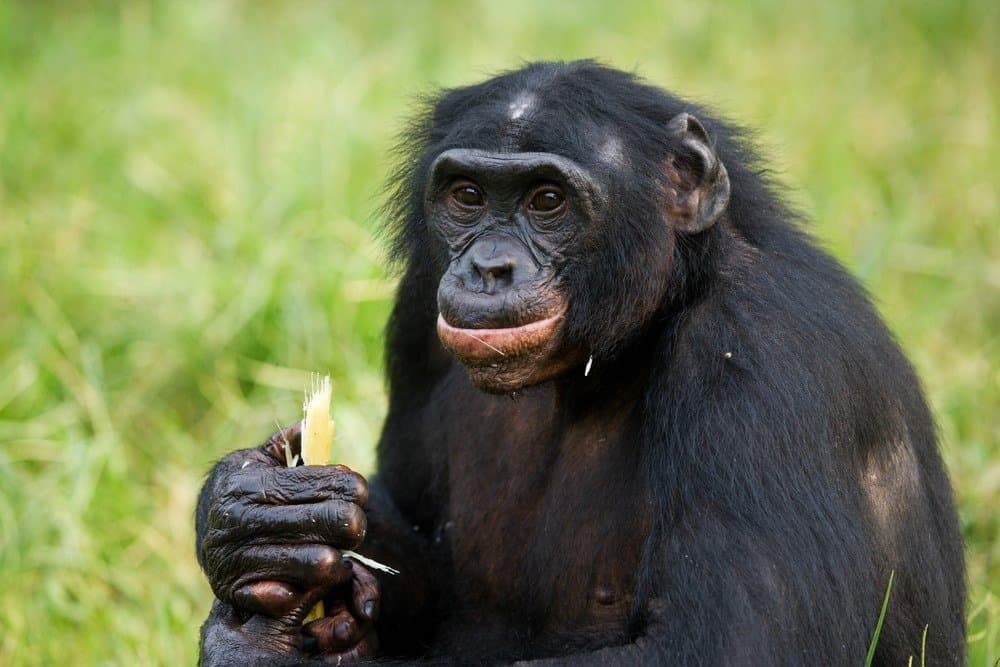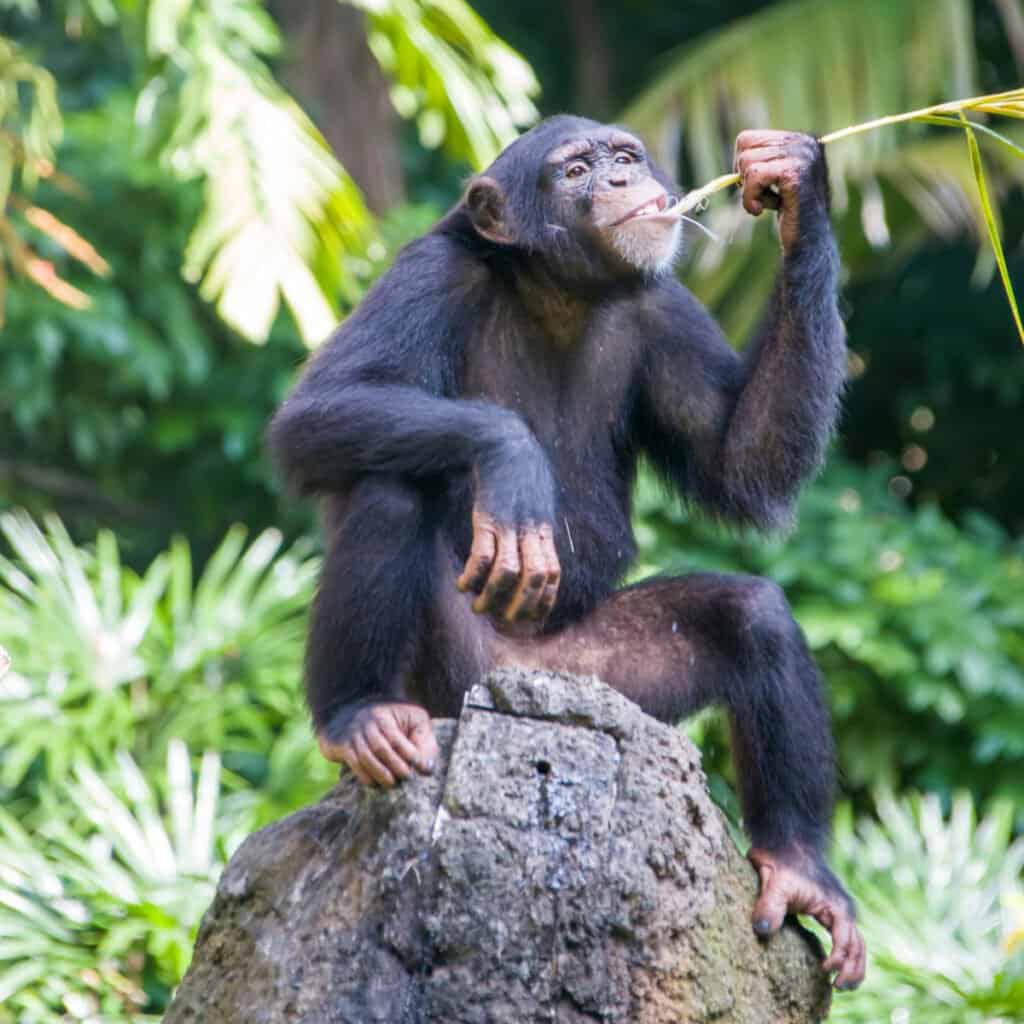Our closest surviving relatives are chimps and bonobos. In addition to our common ancestry, we share about 98% of our DNA with these primates. However, despite their apparent similarities, these two great ape groups were identified as two distinct species in 1929. Bonobos and chimps have distinctly different behaviors that we have, with bonobos displaying what could be considered our better angels. Bonobos make love, not war, while chimps are known to do the exact opposite. That alone gives us a unique perspective on how these two species are so dissimilar. But, other than their behavior, what other differences do bonobos vs chimpanzees have? We’ll look at the characteristics that separate the two creatures in the sections below.
Comparing a Bonobo and a Chimpanzee

| Bonobo | Chimpanzee | |
|---|---|---|
| Appearance | – has a slender and more graceful build – tends to have dark faces with pink lips | – body is more robust – usually born with light faces that freckle and darken with age |
| Diet | – more likely to add vegetables to their diets | – tend to be a bit more carnivorous |
| Behavior | – peace is almost universal across bonobo communities – loves to play silly games | – prone to aggression and bloodshed |
| Body Language | – gesture to suggest sex – standing on two legs – was unique to their species | – leaf clipping where a chimp very obviously takes small bites from leaves is used only to elicit sexual attention |
| Social Structure | – ruled by females to prevent male aggression | – led by an alpha male who won in a competition exhibited through sexual aggression and conflict that is sometimes deadly |
The 5 Key Differences Between a Bonobo and a Chimpanzee
The main differences between a bonobo and a chimpanzee include their appearance, diet, behavior, body language, and social structure. Both chimpanzees and bonobos live in the tropical jungles of Central Africa. However, bonobos have a significantly restricted range. Bonobos only thrive in a tiny area of the Congo River Basin in the Democratic Republic of Congo, while chimpanzees can be found in twelve nations across East, Central, and West Africa. Even though both species live in the Congo River Basin, bonobos live south of the river, and chimps live north. These two animals couldn’t be more opposite, and we’ll go through each of their differences in detail.
Bonobo vs Chimpanzee: Appearance

Bonobos are slightly shorter than chimpanzees.
©GUDKOV ANDREY/Shutterstock.com
It may be difficult to tell the two primates apart at first glance, but there are a few distinctions in appearance between bonobos and chimps. Let’s start with their bodies, which are somehow different. Bonobos have long, lanky limbs and slender builds. They also have dark faces and lips from the moment of birth and pink contours around their lips and eyes upon reaching adulthood.
The bodies of chimpanzees are more robust and muscular than those of bonobos. They are also slightly taller than bonobos when standing on their hind legs, with males towering at 4.3 feet tall, compared to 4.2 feet for bonobo males. Their babies have lighter skin on their cheeks, ears, hands, and feet, which gradually darkens as they get older.
Bonobo vs Chimpanzee: Diet

Chimpanzees and bonobos eat a wide variety of fruits.
©Danny Ye/Shutterstock.com
Chimpanzees and bonobos are primarily frugivores, preferring to eat the wide variety of fruit found in Central Africa’s tropical forests. However, bonobos are more likely to eat vegetables by nibbling on stems, leaves, and blossoms. They hunt for meat roughly twice a month in their communities, and they generously share their haul within the group.
While bonobos won’t turn down protein sources such as worms, insects, or the occasional duiker (small antelope), chimps are more carnivorous. Tied to competition for status and mates, male chimpanzees will engage in violent hunting sprees, primarily targeting the tiny colobus monkeys. Unfortunately, they will also eat infants of other chimp groups as a last resort.
Bonobo vs Chimpanzee: Behavior
Peace reigns almost universally among the Bonobo tribes. They have evolved to avoid confrontation and have never murdered their species. Bonobos generate a stress hormone in response to conflict that stimulates social bonding for reassurance. They are considerate and compassionate towards strangers as they share their food with others, even if they are not in their social group. To reduce stress and avoid conflict, bonobos employ social sexual contact, sometimes known as the “bonobo handshake.” In bonobo society, sexual behavior is not limited to female-male pairings. Many individuals believe this behavior is the key to bonobos’ peaceful temperament, especially compared to chimp colonies where sex is competitive.
In contrast, when presented with conflicts, chimps secrete testosterone, which is related to aggression. These apes can be particularly aggressive toward stranger chimps, and they must be tough to survive. In chimp society, alpha males guard fertile females and frequently battle for reproductive success.
Bonobo vs Chimpanzee: Body Language
Both great apes species have intricate communication systems that share key characteristics. However, their vocalizations sound considerably different. Bonobos have a higher-pitched voice that sounds like squeals and yelps. They also have a unique gesture to suggest sex: standing on two legs.
Chimpanzees have lower-pitched voices similar to barks and grunts. Some of the chimps’ gestures are unambiguous, meaning they are employed consistently to express one meaning. Leaf clipping, for example, in which a chimp takes little bites from leaves to seek sexual attention.
Bonobo vs Chimpanzee: Social Structure
One of the most significant contrasts between our evolutionary ancestors is that females are in authority in bonobo society. It is achievable because female alliances work together to avoid male violence by compensating for size differences through numbers. In contrast to the often antagonistic exchanges between chimp groups, the females maintain peace inside their society and among their neighbors.
Chimpanzees are patriarchal, with a single alpha male leading the pack. Male chimps live in a culture dominated by competitiveness, which manifests itself in sexual aggression and often lethal violence. Chimps are known to commit infanticide and cannibalism to boost their chances of fathering offspring. Bloodshed is a trait shared by chimps and humans but rarely seen in bonobos.
The photo featured at the top of this post is © GUDKOV ANDREY/Shutterstock.com
Thank you for reading! Have some feedback for us? Contact the AZ Animals editorial team.






